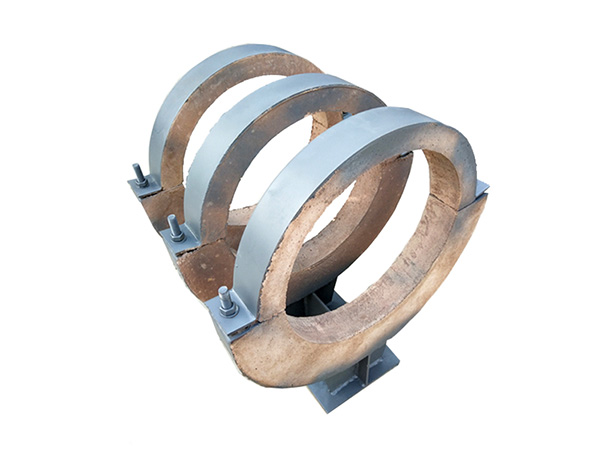Industrial Safety Applications of Fire-Resistant Pipe Insulation Brackets
Author:Mingde Time:2025-10-17 09:06:27 Click:81
In high-temperature industrial environments, the smallest component can make the biggest difference.
Among these, the Pipe Insulation Bracket—a crucial link between insulation and structure—ensures both safety and energy efficiency.
When engineered with fire-resistant materials, these brackets become a key line of defense during emergencies, protecting not only pipelines but also the surrounding equipment and personnel.
As global industries pursue safer and more sustainable infrastructure, China manufacturers and bulk suppliers are taking the lead in offering high-performance, cost-efficient solutions that meet international standards.


1. What Makes a Fire-Resistant Pipe Insulation Bracket Essential
Unlike standard supports, fire-resistant Pipe Insulation Brackets are built to maintain structural and thermal integrity under extreme heat or flame exposure.
Their role extends beyond simple mechanical support — they preserve insulation effectiveness and prevent catastrophic failure during fires.
Core performance objectives include:
·Withstanding direct flame and radiant heat exposure.
·Preserving pipeline insulation integrity.
·Maintaining load-bearing strength under high temperatures.
·Reducing fire propagation along the pipeline system.
In heavy industrial plants and refineries, where a few minutes can mean the difference between containment and disaster, these brackets are an engineering necessity.
2. Material Technology and Fireproofing Innovation
Modern Pipe Insulation Brackets use advanced fireproof materials and surface treatments designed for thermal resistance and long-term reliability.
Common engineering materials include:
·Stainless steel for corrosion and oxidation resistance.
·Carbon steel with refractory coating for structural stability.
·Ceramic fiber or mineral wool inserts for heat insulation.
·Epoxy or intumescent coatings that expand under high heat, forming a protective barrier.
The combination of mechanical strength and fire resistance ensures brackets maintain their form and load distribution during intense temperature fluctuations.
Advanced FEA (Finite Element Analysis) simulations, widely adopted by China suppliers, allow precise modeling of thermal stress, ensuring consistent quality even in bulk manufacturing.
3. Fire Resistance in Industrial Protection Systems
Fire events in industrial settings such as oil, gas, and chemical facilities can spread rapidly through interconnected pipelines.
Using fire-resistant Pipe Insulation Brackets can significantly reduce heat transfer along the system, helping isolate affected zones.
Key safety benefits:
·Limits flame spread by maintaining insulation coverage.
·Provides time for emergency response and system shutdown.
·Reduces potential for mechanical collapse due to thermal distortion.
·Enhances compliance with fire safety standards (ASTM, ISO, EN).
These brackets work as passive fire protection systems, combining mechanical precision with engineered thermal barriers — a vital safeguard in complex process networks.
4. Industrial Application Scenarios
Fire-resistant Pipe Insulation Brackets are widely used across multiple industrial sectors where safety and temperature stability are mission-critical.
Oil & Gas Refining
In petroleum refineries, fire-rated brackets prevent insulation collapse during hydrocarbon fires, protecting mainline integrity and reducing downtime.
️ Chemical Production
Pipelines carrying corrosive or flammable liquids require brackets that resist both chemical attack and high heat — ensuring continuous operation even under fire exposure.
Power Generation
Steam and condensate lines in thermal plants operate under extreme pressure and temperature; fire-resistant brackets ensure consistent insulation performance and thermal control.
District Heating Systems
Long-distance heating networks rely on fire-protected supports to maintain insulation integrity while preventing energy loss in high-temperature environments.


5. Digital Design and Production in China’s Manufacturing Sector
Today’s China manufacturers combine traditional metalworking expertise with digital simulation, 3D modeling, and robotic fabrication to achieve exceptional precision in pipe support production.
These factories operate with automated inspection and real-time testing systems that verify fire performance under controlled conditions.
Partnering with a China supplier offers several benefits:
·Bulk supply capacity for large-scale industrial and energy projects.
·Flexible customization of bracket geometry and insulation types.
·Certified quality systems (ISO, ASTM, UL fire compliance).
·Rapid production cycles with strict dimensional consistency.
These competitive advantages allow global clients to integrate reliable, fire-tested Pipe Insulation Brackets directly into project designs, without compromising on budget or lead time.
6. Testing and Certification: Meeting Global Safety Standards
To ensure reliability, all fire-resistant Pipe Insulation Brackets must undergo rigorous fire, load, and durability testing.
Standardized testing verifies resistance to high temperatures, flame exposure, and deformation.
Commonly referenced standards include:
·ASTM E119 – Standard test for fire endurance.
·UL 1709 – Fire resistance testing for hydrocarbon fire exposure.
·EN 1366-3 – European fire test for service installations.
·ISO 834 – Global benchmark for fire exposure performance.
These certifications ensure that brackets can maintain insulation attachment and load capacity during real fire events — a non-negotiable requirement for modern industries.
7. Toward a Smarter and Sustainable Future
The evolution of Pipe Insulation Brackets is moving toward smarter, greener, and more data-driven solutions.
With the integration of AI-based design tools, digital twins, and IoT monitoring, manufacturers can predict bracket behavior under real operating conditions.
Emerging trends include:
·Use of recyclable, low-carbon alloys for sustainable manufacturing.
·Predictive modeling for thermal fatigue and vibration response.
·Embedded sensors for temperature and stress monitoring.
·Smart fire-resistant coatings with self-healing properties.
These innovations are being rapidly adopted by forward-looking China manufacturers, strengthening their position as global leaders in industrial pipeline safety components.
Conclusion
Fire-resistant Pipe Insulation Brackets represent the intersection of safety, engineering, and innovation.
They preserve thermal insulation, structural balance, and operational stability during the most demanding conditions.
Choosing a China manufacturer with bulk supply capabilities means access to advanced digital design, certified materials, and proven fire protection performance.
As industrial projects grow in scale and complexity, these precision-engineered brackets continue to define the standard for reliable, energy-efficient, and fire-safe pipeline infrastructure.
References
GB/T 7714:Wu J, Li W, Huang F, et al. Simulation of Internal Environmental Conditions Within Rock Wool Insulation: Implications for Corrosion Under Insulation in Piping Systems[J]. Coatings, 2025, 15(5): 571.
MLA:Wu, Jiangshun, et al. "Simulation of Internal Environmental Conditions Within Rock Wool Insulation: Implications for Corrosion Under Insulation in Piping Systems." Coatings 15.5 (2025): 571.
APA:Wu, J., Li, W., Huang, F., Zhang, H., Zhang, B., Liu, F., & Jin, Y. (2025). Simulation of Internal Environmental Conditions Within Rock Wool Insulation: Implications for Corrosion Under Insulation in Piping Systems. Coatings, 15(5), 571.
 Hot Products
Hot Products
 Contact Us
Contact Us
Contact:
Mobile:+86 +86 19133378808
Website:mingdepipe.com
Address:










